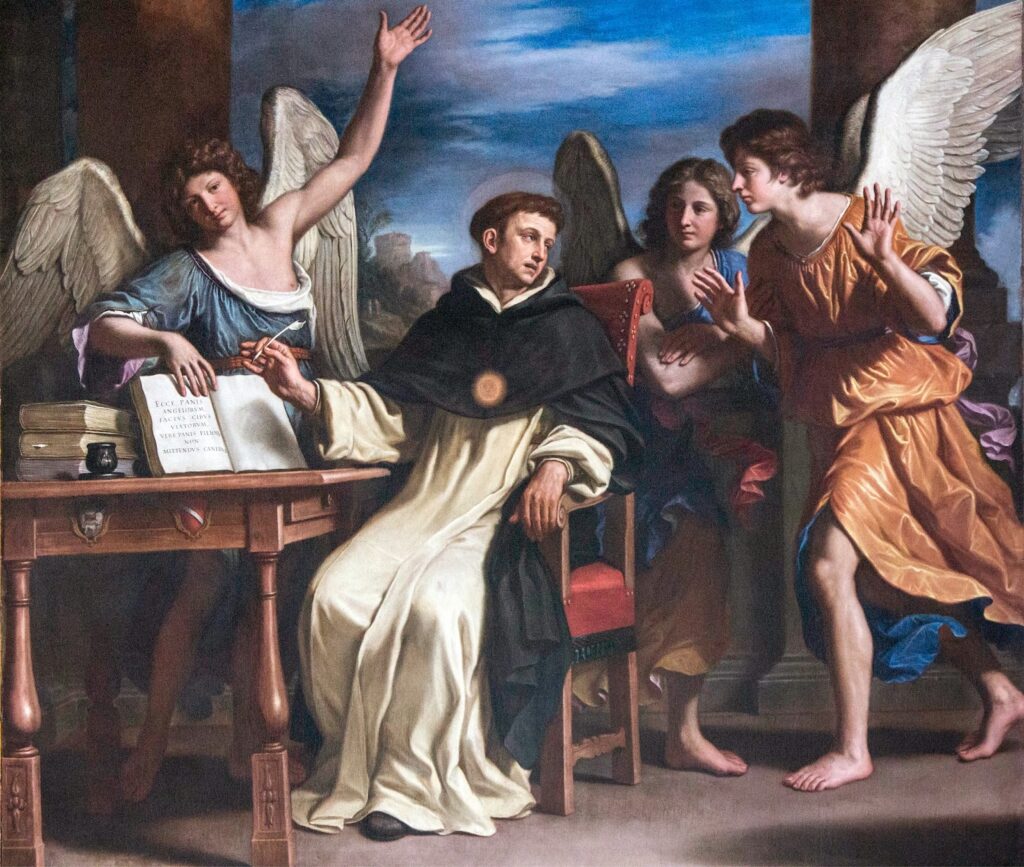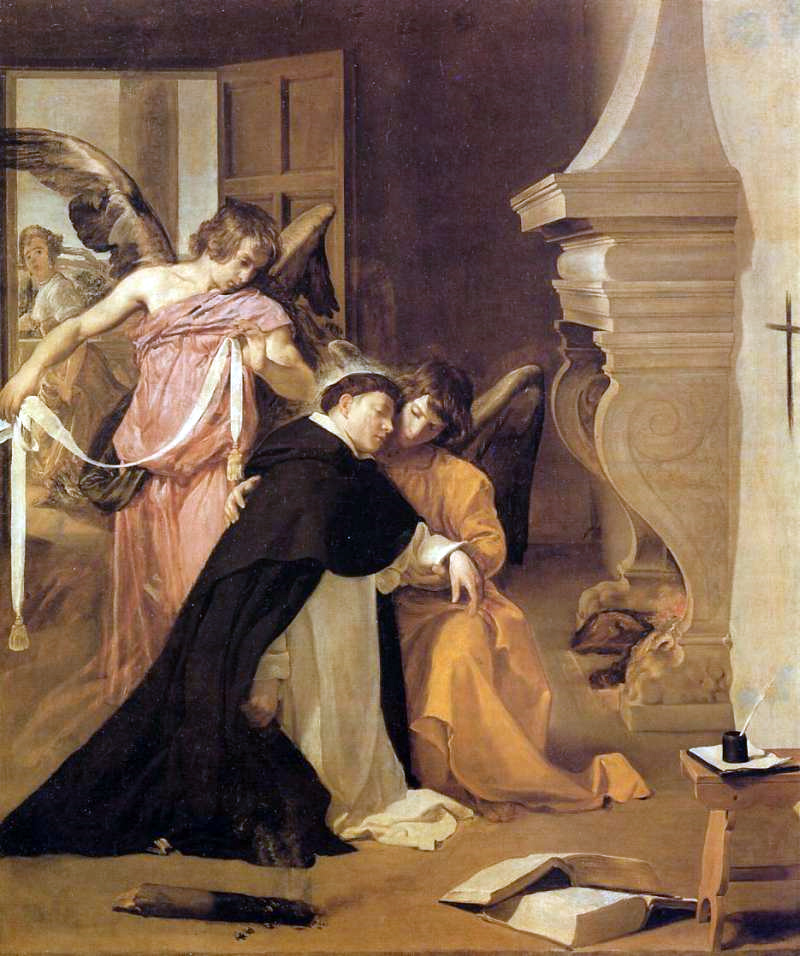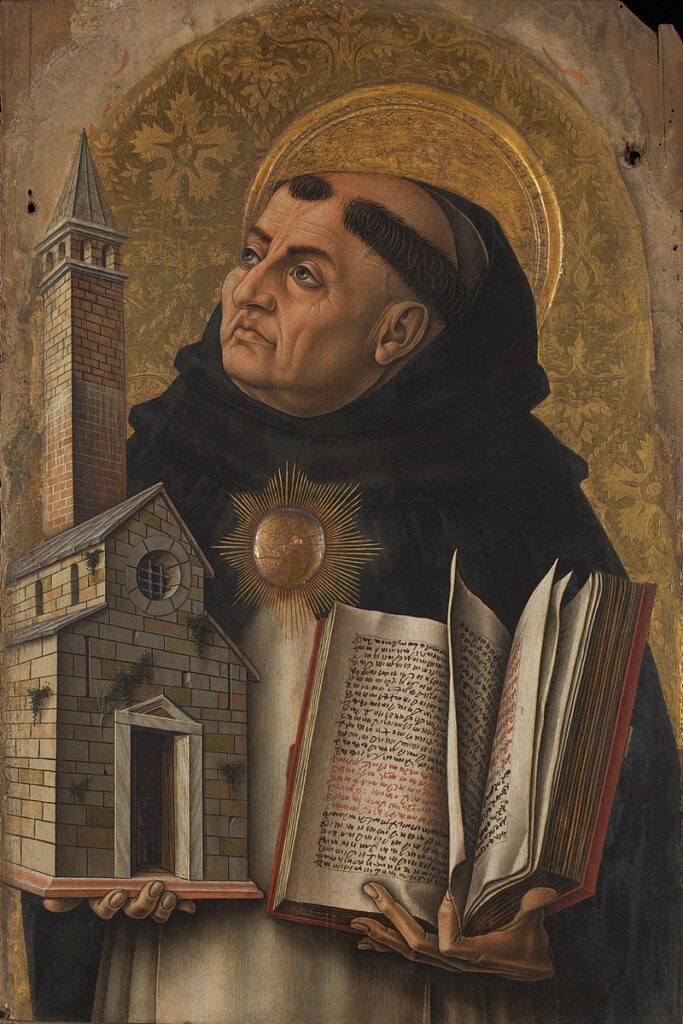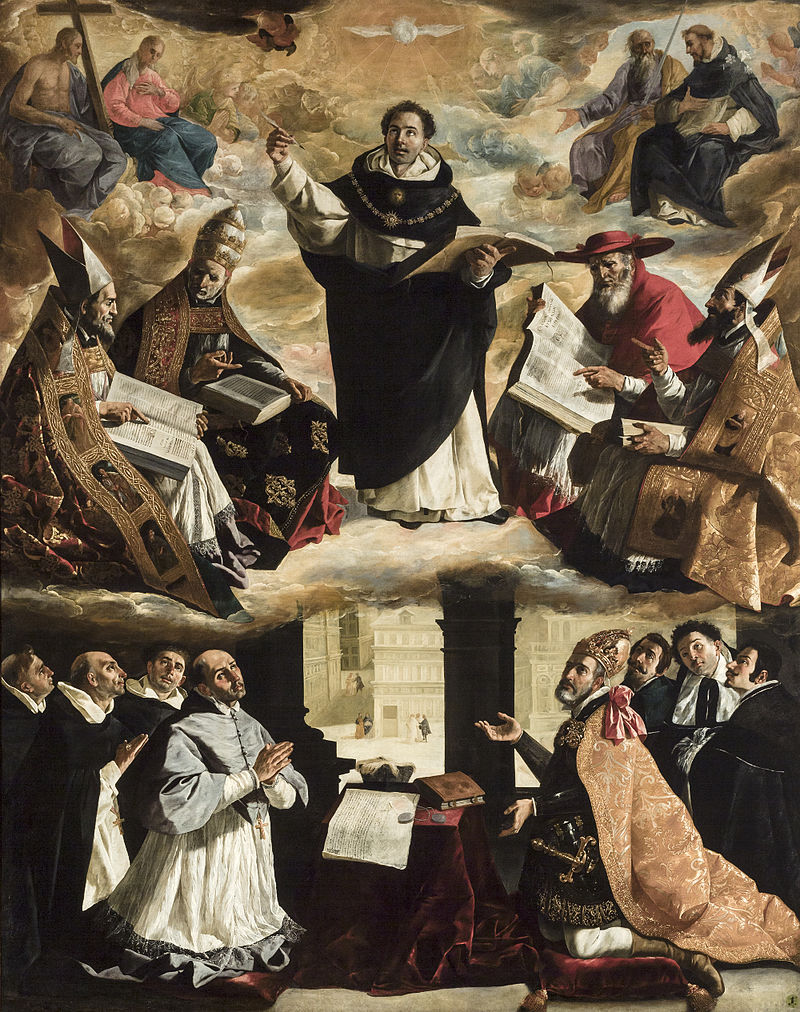On January 28, the day dedicated to the memory of Saint Thomas Aquinas (1225-1274), an eminent figure of the Catholic Church and Western thought, we are invited to reflect on his iconography in art. Thomas, a Dominican friar, theologian, and philosopher, earned the title of “Doctor Angelicus” for the depth and purity of his thinking. His ideas have left an indelible mark not only in theology but also in the visual arts.
In the painting “Saint Thomas Aquinas Writing Assisted by Angels” by Guercino, housed in the Basilica of San Domenico in Bologna, Saint Thomas’s figure is intensely depicted in the fervor of theological composition. The scene is imbued with an aura of sanctity and concentration, with the saint portrayed sitting, engrossed in his work, symbolizing his dedication to study and reflection. The angels beside him are not mere spectators, but active participants in his creative process, suggesting a celestial connection guiding his pen.
Guercino, with his ability to capture the emotional intensity and spirituality of his subjects, lends this canvas an almost ethereal quality. The angels, rendered in vibrant colors and expressive gestures, are depicted in the act of inspiring and comforting the saint, each in a pose reflecting a different aspect of divine inspiration: from announcement to support to enlightenment.
The composition of the painting guides the viewer’s eye towards the thoughtful face of Saint Thomas, highlighting the depth of his theological meditation. The presence of books and documents on the table beside him is not just a realistic detail but also emphasizes the vastness of his intellect and the scope of his erudition. Guercino thus celebrates Saint Thomas not only as a saint but also as a pillar of Christian thought, an intellectual who embodies the union between faith and reason. The table, solid and functional, symbolizes the earthly foundation of his pursuit of truth, while the light penetrating the room and illuminating the scene underscores the presence of the spiritual in the intellectual process.
Then follows the representation by Diego Velázquez (1599-1660) in “Saint Thomas Aquinas” (1632, Orihuela Cathedral, Spain). Known for his realism and ability to capture the essence of his subjects, Velázquez offers a more human and accessible vision of the saint, highlighting his wisdom and guiding role in the Church.
At the center of the scene is Saint Thomas, whose black robe and focused face immediately convey his deep devotion and intellectual commitment. The saint is depicted in a moment of divine inspiration: an angel whispers in his ear, symbolizing the celestial guidance informing his theological writings. The angel’s presence, with its rosy complexion and the soft drapery of its garment, adds a supernatural dimension to the work, emphasizing the connection between the saint and the divine.
Velázquez uses a palette of warm, earthy colors to create a sense of closeness and intimacy, drawing the viewer into the saint’s study. The light entering from the window in the back delicately illuminates the scene, highlighting the thoughtful face of Saint Thomas and the white of the robe he wears, symbolizing purity and his affiliation with the Dominican Order.
Every detail is carefully considered to communicate the saint’s wisdom and guiding role: books scattered on the floor and a small work table with ink and a pen ready for use reflect the intense intellectual work and his dedication to writing and study. These elements, along with the barely visible crucifix on the pillar in the background, emphasize the importance of faith and theological work in Saint Thomas’s life.
Velázquez’s realism emerges not only in the physical representation of the saint and angels but also in portraying the emotional and psychological depth of his subject. The saint’s posture, bent forward in a gesture of humble reception of celestial knowledge, expresses his humility and ardent desire for spiritual understanding.
It is remarkable how Velázquez balances the composition between the saint’s earthly presence and the divine intervention of the angels, creating a visual bridge connecting heaven and earth. The artist’s technical mastery, combined with his ability to evoke the inner life of his subjects, makes this painting an eloquent example of his work and a rich visual document that continues to speak to future generations about Saint Thomas Aquinas.
Carlo Crivelli (1430-1495), in his portrait of the Saint (1476, National Gallery, London), illustrates the complexity of the dialogue between faith and reason. The figure of the Saint, with a thoughtful and severe face, is framed by a Dominican habit, immediately revealing his affiliation with the Order of Preachers. It’s not only the robe that speaks, but also the golden halo shining behind his head, symbolizing his sanctity and enlightened guidance.
In the image, Saint Thomas holds an open book, occupying a central role in the painting. The text, intricately illustrated, can be seen as the corpus of his work, the Summa Theologica, representing a heroic attempt to synthesize Christian theology and Peripatetic philosophy. The presence of the radiant sun on the Saint’s chest, radiating light, symbolizes divine truth and knowledge, the intellectual enlightenment Saint Thomas sought to spread through his writings.
The building depicted beside him might allude to the solidity of Christian institutions or perhaps symbolize the house of wisdom that Thomas sought to build through his work of reconciling faith and reason. The plants sprouting from its structure might represent the growth and flourishing of knowledge that blooms from the foundation of faith.
In the majestic work “Apotheosis of Saint Thomas Aquinas” by Francisco de Zurbarán, preserved in the Museo de Bellas Artes in Seville, the essence and influence of the great theologian and philosopher Saint Thomas Aquinas are exalted through a representation that unites the celestial with the earthly. Saint Thomas is magnificently placed at the center of the scene, a focal point of connection between the divine and the human, depicted standing, with an elevated gaze towards an assembly of spiritual and intellectual figures who seem to partake in a transcendent dialogue.
Zurbarán employs chiaroscuro to emphasize the figure of the saint, whose eloquent gestures and illuminated face become symbols of his clarity of thought and erudition. Around him, sacred characters and philosophers from various epochs demonstrate, through their expressions and attitudes, admiration and respect for the saint’s teachings. The divine light pouring from above accentuates his central figure, underscoring the significance of his theological work.
The artist evokes reverence for Saint Thomas through the depiction of scholars and faithful gathered at his feet, who look towards the saint with devotion and aspiration, reflecting the profound impact of his thought throughout the centuries. The architecture in the distance suggests the academic and religious institutions that have preserved and disseminated his ideas, while the discreet presence of the cross reaffirms his steadfast dedication to the Christian faith. With this canvas, Zurbarán not only pays homage to Saint Thomas but also celebrates the ability of art to serve as a bridge between intellectual pursuit and spirituality, offering an intense glimpse into a moment of divine revelation that unites heaven and earth.
Saint Thomas is easily recognizable in artworks due to certain distinctive attributes. He is always dressed in the Dominican habit, a white tunic with a black, pointed cape and hood, sometimes accompanied by a white scapular. This attire not only signals his membership in the Order of Preachers but also reflects his humility and dedication to religious life.
Another recurring element is the radiant sun, often located on the saint’s chest, sometimes replaced by a star. This symbol represents the light of knowledge and wisdom that Saint Thomas spread through his writings and teachings. In some works, such as in the painting by Carlo Crivelli, Saint Thomas is depicted holding a church or a book, symbols of his devotion to theology and philosophy.
Representations of Saint Thomas often include scenes where he is honored by saints, church doctors, and pagan philosophers, thus acknowledging his impact and contribution to Christianity and Western thought. The iconography of Saint Thomas Aquinas in art reflects his exceptional legacy as a philosopher, theologian, and spiritual guide, and continues to inspire and influence art and thought to this day.















